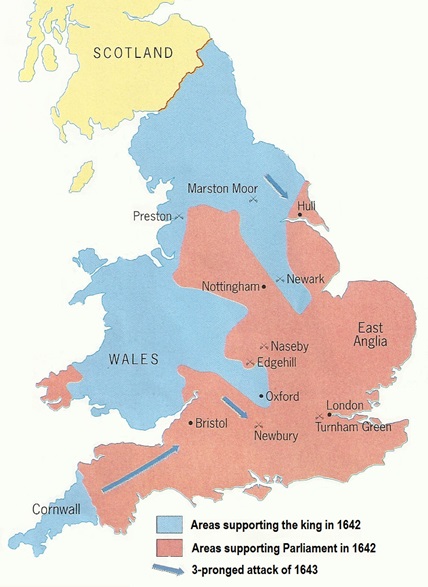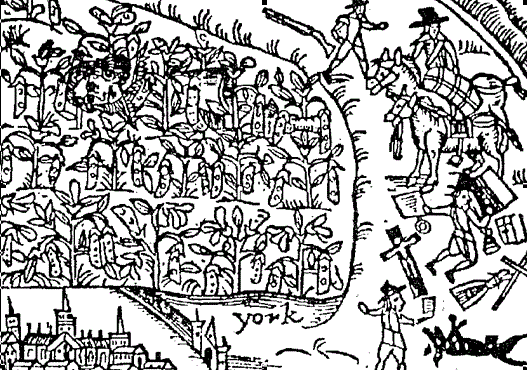
The Events of the Civil Wars

Introduction
This webpage studies the course of the Civil Wars.
After you have studied this webpage, answer the question sheet by clicking on the 'Time to Work' icon at the top of the page.
Links:
The following websites will help you research further:
Course of the Civil War:
•
(Detailed) timeline
•
Civil Warfare (Why Parliament Won)
•
Video
!
1642
The Civil War started on 22 August 1642, when Charles I raised his standard in Nottingham. Most of Parliament's support came from the south and the east of the country. The king held the north, Wales and the West Country.
The first big battle of the war was fought on 23 October 1642, at Edgehill in Warwickshire. The royal cavalry, led by the king's nephew, Prince Rupert, defeated Parliament's cavalry, but then turned away to chase the enemy. The result was a confused draw.
The battle horrified a Puritan landowner and MP from East Anglia called Oliver Cromwell. He saw how good the king's cavalry was:
Our troops are most of them old serving men, and their troops are gentlemen's sons and persons of quality. Do you think our poor fellows will ever be able to defeat gentlemen that have courage and determination?
Cromwell went back to East Anglia to train an army of men 'who had the fear of God before them'.
Charles advanced towards London, but thousands of citizens turned out to stop him. They built earth mounds and put snipers in every cottage, shed and hedge. On 12 November 1642, at Turnham Green, Charles was forced to turn back.
A map of the Civil War.

1643
In 1643, the king planned a campaign which he hoped would win the war. Three Royalist armies advanced on London at the same time – one from the North, one from Cornwall, and a third from the king's headquarters at Oxford.
The plan failed. The southern army was held up at Bristol, and the northern army was held up at Hull. Finally, the king failed to defeat Parliament's army at Newbury (20 September 1643) because he ran out of ammunition.
1644
Slowly, Parliament began to win.
The navy supported Parliament, so Parliament captured all the ports. This stopped Charles getting help from abroad. Parliament raised large sums of money – it put a new tax on food. Charles began to run out of money. Also, on 23 November 1643, Parliament had joined forces with the Scots, who sent an army of twenty thousand men to fight the king.
Most importantly of all, Cromwell's new soldiers were now ready for battle. The `Ironsides' were well trained and well disciplined. They spent their spare time praying and talking about politics. On 2 July 1644, at Marston Moor near York, they made a surprise attack when the Royalists were having their evening meal. About three thousand Royalist soldiers were killed .

Prince Rupert hiding in a beanfield after the battle of Marston Moor – can you see him?
Rupert had a large white dog called Boy; many Parliamentary soldiers thought Boy was an evil spirit which helped Rupert win battles. What have the soldiers found? What colour is Boy in the picture? Why?
Which side did the artist support?
1645
On 3 April 1645, Parliament re-organised its army along the lines of Cromwell's Ironsides. They called it the New Model Army.
On 14 June 1645, the New Model Army destroyed the king's forces at Naseby in Northamptonshire. The king fled. Many of his soldiers were killed or captured. He lost all his guns, his supplies and his private papers.
1646-48
The king had lost. On 5 May 1646, he surrendered to the Scots at Newark. Both Parliament and the New Model Army tried to come to an agreement with the king.
Charles schemed and lied. On 26 December 1647 he made a treaty with the Scots, who invaded England. This was the start of the Second Civil War (1 May 1648).
The Second Civil War ended on 20 August 1648, when Cromwell defeated the Scots at Preston in Lancashire. Cromwell and the soldiers were furious with the king. T hey promised to 'call Charles Stuart, that man of blood, to account'.